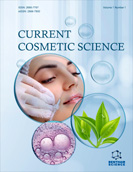- Home
- A-Z Publications
- Current Cosmetic Science
- Issue Home
Current Cosmetic Science - Current Issue
Volume 3, Issue 1, 2024
-
-
Enhancing Collaboration and Interdisciplinary Strategies for Navigating Innovative Technologies and Regulatory Approvals in the Cosmetic Industry
More LessAuthors: Divyesh H. Shastri, Shivani Gandhi and Hugo AlmeidaThe cosmetic industry, driven by innovation, constantly seeks safer, more effective, and sustainable products. However, regulatory hurdles often impede the introduction of innovative cosmetics. This paper explores the convergence of advanced technologies and regulatory conformity, emphasizing the need for collaborative, interdisciplinary approaches.Through an extensive review of literature and case studies, we rev Read More
-
-
-
Development and in vitro Evaluation of Nanoemulsion-based Polyherbal Hair Serum Formulations for Leave-in Hair Treatments
More LessAuthors: Sheba R. David and Rajan RajabalayaBackgroundHair is a prominent physical feature that is found in all mammals. Different hair types will display different hair physicochemical properties (colour and appearance), mechanical resistance and reactivity to chemical agents and surface properties.ObjectivesThis study aims to prepare polyherbal-based hair serum to conduct stability tests and in-vitro evaluation tests to assess the efficacy of hair serum on differ Read More
-
-
-
Tannic acid and Gallic Acid as Alternative Compounds for the Application as Preservatives in Cosmetic Products
More LessIntroductionTannic acid and gallic acid have been known as natural compounds with antibacterial activity. In this work, the antimicrobial efficiency of tannic acid (TA) and gallic acid (GA), as well as their mixtures, was tested.MethodsDuring the research, the minimal inhibitory concentration, minimal bactericidal concentration, and fractional inhibitory concentration were defined. Based on them, for further study, mixtures of T Read More
-
-
-
Potential Beneficial Effects of Mineral Sunscreens on Acne-Prone Skin
More LessAuthors: Marina Gomes, Fabiana Vieira Lima, Catarina Rosado and Bianca Ramos PezziniBackgroundSunscreens are critical products used against harmful ultraviolet (UV) radiation. However, beyond the effect of sun protection, the inorganic UV filters zinc oxide and titanium dioxide have shown antimicrobial activity.ObjectiveThis study aimed to evaluate the potential additional beneficial effects of mineral sunscreens containing zinc oxide and titanium dioxide as antimicrobial agents on acne-prone skin.MethodsT Read More
-
-
-
Facial Exercises: Enhancing Facial Structure and Reducing Signs of Aging - A Comprehensive Review
More LessThe effectiveness of facial muscle exercises (FMEs) for facial rejuvenation is still quite controversial in the scientific literature. In general, published studies use non-quantitative parameters to assess the real benefit of FMEs. In this study, we reviewed the scientific evidence related to the efficacy of FMEs for facial rejuvenation, as well as to describe the most used FMEs in scientific studies. To achieve the objective of this review, res Read More
-
-
-
Determining Anti-Acne Potential of Azadirachta Indica Leaf Powder, Herbal Hydrogel using S. Aureus Growth Inhibition Model, by Agar Well Diffusion Technique
More LessAuthors: Harish Kumar, Madhu Verma, Harshit Garg, Ishu Garg and Ishika SharmaBackgroundNeem (Azadirachta indica) can be considered as a boon to mankind as it possesses innumerable medicinal benefits despite being cost effective. Its use as an anti-acne agent is widely anticipated. A topical formulation of neem leaf powder as hydrogel was prepared recognizing the use of its phytoconstituents in many skin therapies. The primary goal of topical formulations is to provide drug contact with the skin whil Read More
-
-
-
Development of Aged Skin Equivalent Model
More LessAuthors: Luiza Meurer Brand, Marcelo Lazzaron Lamers and Bibiana Franzen MatteBackgroundSkin aging is a result of the aging process and also intrinsic and extrinsic factors. In order to better understand this process and evaluate anti-aging products, it is necessary to develop in vitro models that can recapitulate the biological process of aged skin. Therefore, the aim of this study was to develop an aged skin equivalent model to evaluate these properties.MethodsHuman fibroblasts were incorporated in Read More
-
-
-
The Perspective of Unani Medicine in Understanding Melasma – A Review
More LessMelasma, a prevalent hyperpigmentation skin disorder, poses significant challenges in dermatology clinics. Despite its global impact, conventional treatment options often entail potential side effects and limitations, necessitating the search for alternative therapeutic strategies.This narrative review aims to advance the understanding of melasma from the perspective of Unani medicine, an ancient healing system recognized b Read More
-
-
-
Exploring the Application of Artificial Intelligence in Cosmetics and Beauty Industry
More LessAuthors: Harshita Mathur, Anurag Chaudhary, Devkant Sharma and Alok SharmaThe present work highlights how AI can enhance the personalized cosmetic experience based on the digitalization of make-up by consumers, the selection of perfect product characteristics and optimization of new cosmetic products on the basis of big data. Moreover, the different AI technologies applied in cosmetics have also been presented in a concise manner. Cosmetic companies are advancing and are expected Read More
-
Volumes & issues
Most Read This Month Most Read RSS feed
Article
content/journals/cosci
Journal
10
5
false
en


